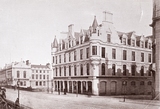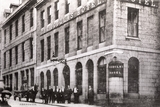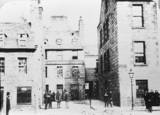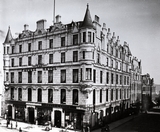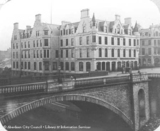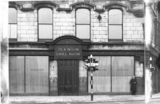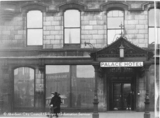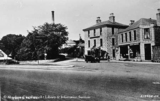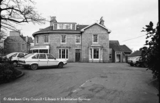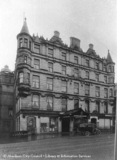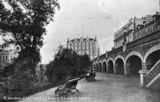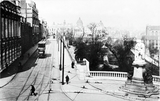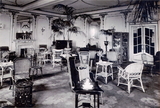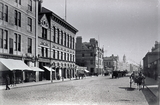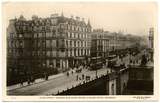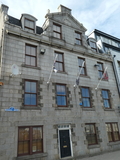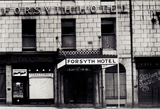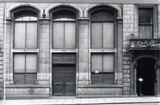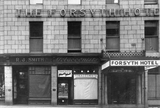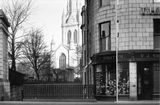|
Quick Search
|
Search Results
You searched for: Subject matches "Hotels" or its children
38 items
items as
Palace Hotel, Union Street
10 The Palace Hotel, Union Street. Built 1874 for Messrs Pratt and Keith, milliners, who occupied the street level area, it operated as one of a chain of LNER hotels. Its upper stories were destroyed by fire on 31 October 1941 with loss of life, and the building was entirely demolished after the war. The Douglas Hotel, Market Street
411 The Douglas Hotel on Market Street. Built 1848. Building in current form designed by A. Marshall Mackenzie 1937. Lemon Tree Hotel, Huxter Row
679 Lemon Tree Hotel, Huxter Row, off Castle Street, which was demolished to make way for the Town House in the 1870s. The title was transferred to a house in St. Nicholas Street and more recently to the Lemon Tree arts venue in West North Street.
Huxter Row was a narrow street running from Broad Street, parallel with Union Street, to the old Town House and then joining Union Street at right angles. The street derived its name because of the booths of hucksters - small traders. The Palace Hotel
716 The Palace Hotel, Union Street. The hotel was built in 1874 for Messrs Pratt and Keith, milliners, who occupied the street level area. It operated as one of a chain of LNER hotels. Its upper stories were destroyed by fire on 31st October 1941, with loss of life, and the building was entirely demolished after the war. Union Bridge showing the Palace Hotel
752 Union Bridge on Union Street, showing the Palace Hotel. The hotel was built in 1874 for Messrs Pratt and Keith, milliners, who occupied the street level area. It operated as one of a chain of LNER hotels. Its upper stories were destroyed by fire on 31st October 1941, with loss of life, and the building was entirely demolished after the war. Tea room and grill room, Palace Hotel
824 The tea room and grill room at the Palace Hotel, Union Street. The hotel was built in 1874 for Messrs Pratt and Keith, milliners, who occupied the street level area. It operated as one of a chain of LNER hotels. Its upper stories were destroyed by fire on 31st October 1941, with loss of life, and the building was entirely demolished after the war. Palace Hotel, Union Street
825 The Palace Hotel, Union Street. The hotel was built in 1874 for Messrs Pratt and Keith, milliners, who occupied the street level area. It operated as one of a chain of LNER hotels. Its upper stories were destroyed by fire on 31st October 1941, with loss of life, and the building was entirely demolished after the war. Palace Hotel, Union Street
826 Palace Hotel, Union Street, showing Kelly's Cat on Union Bridge. The hotel was built in 1874 for Messrs Pratt and Keith, milliners, who occupied the street level area, it operated as one of a chain of LNER hotels. Its upper stories were destroyed by fire on 31st October 1941, with loss of life, and the building was entirely demolished after the war. The Prince Regent Hotel
1115 The Prince Regent Hotel with the entrance to 'The Jug' pub on the right. The house was once owned by Tommy Scott Sutherland, the famed architect. Copthorne Hotel
1120 The facade of the Copthorne Hotel on Huntly Street. The bottom two stories of the Huntly Street multi-storey flats are on the right of the photograph. Union Terrace Gardens, c. 1910
1736 A view of Union Terrace Gardens, Aberdeen. The centre of the picture is dominated by the prestigious Palace Hotel on Union Street, which was built in 1873 by Pratt & Keith, drapers. In 1891, the hotel was acquired by the Great North of Scotland Railway Company and quietly established a high reputation for itself. The building was destroyed by fire in 1941 and was never rebuilt. The gardens themselves have always been a popular meeting and walking place in the centre of town for city residents and visitors alike. The arches to the right are those which support Union Terrace. Union Terrace
2498 A postcard showing Union Terrace from its junction with Union Street. The sign for the Grand Hotel is visible on the left. The Central Library and St. Marks Church are visible at the end of the street. The statue of Edward VII is on the right. The Palace Hotel
2674 The lounge of the Palace Hotel on Union Street. The hotel was demolished after the Second World War, following a serious fire in 1941. Market Street
2675 A George Washington Wilson photograph showing a busy scene at the junction of Market Street and Trinity Quay. The Douglas Hotel can be seen in the centre and a butcher called Alexander Wyness is on the near left. Train tracks are visible on the cobbled streets. Guild Street
2691 Guild Street, Aberdeen, with Her Majesty's Theatre, later named the Tivoli at the left of the image. Union Street, showing New Union Bridge and Palace Hotel
2724 An Adelphi Real Photograph Series postcard (no. 42) showing a busy scene at the junction of Union Street, Union Terrace and Bridge Street in the early 20th century. Various trams, cabs, bicyclists and pedestrians can be seen going about their business. 52 Regent Quay
2750 A photograph of 52 Regent Quay, at the south eastern corner of James Street, taken in July 2018. Note the Aberdeen Harbour Board street sign.
Aberdeenshire: South and Aberdeen (2015) by Joseph Sharples, David W. Walker and Matthew Woodworth, from the Buildings of Scotland series, tells us that the building dates from the 18th century but was raised another storey in 1896-97 by architects Ellis & Wilson so it could be used as a hotel (p. 256). 98-104 Union Street
2791 City Goldsmith Co. at 98, the Forsyth Hotel at 102 and James Yule & Son, Ltd., tobacconists, at 104 Union Street in around 1937. Burlington House and 40 Union Street
2828 The entrance to Burlington House (38 and a half) on Union Street in 1937. This was a hotel of sorts at the time run by Miss Maie Bradley. The Bank of Scotland can also be seen at 40 Union Street. James Macdonell was the then bank agent. 102-106 Union Street
2833 The Forsyth Hotel at 102, Findlay & Co., Ltd., tobacconists, at 104 and R. J. Smith, draper, London house, at 106 Union Street in 1937. 104 Union Street
2834 R. J. Smith, tobacconists, 104 Union Street, with The Forsyth Hotel above, in 1937. St. Nicholas Church can be seen in the distance beyond the stairs leading to Correction Wynd. The façade of the churchyard is on the left of the image. |



